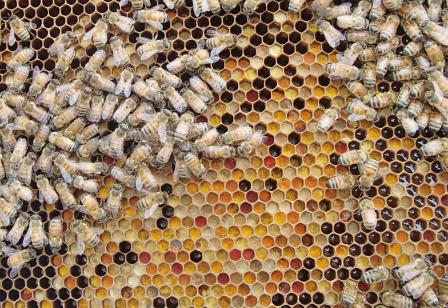Protecting Pollinators
Published June 18, 2019
 The different pollen colors come from a variety of plant species. Photo Credit: EPA's Bonnie Smith. What’s all the buzz about pollinators? Pollinators include insects such as bees, wasps, sawflies, butterflies, moths, beetles, flies, and vertebrates including some birds and bats. These animals contribute to healthy ecosystems since they are responsible for helping 90% of the world’s flowering plants reproduce. However, the most recognized pollinators, honey bees, have experienced a decline in the U.S. and many other countries according to the NAS’ 2007 Status on Pollinators in North America. No single issue is believed to be responsible for the decline in honey bee populations, however, some risk factors include pests and pathogens, poor nutrition, pesticides, and habitat loss.
The different pollen colors come from a variety of plant species. Photo Credit: EPA's Bonnie Smith. What’s all the buzz about pollinators? Pollinators include insects such as bees, wasps, sawflies, butterflies, moths, beetles, flies, and vertebrates including some birds and bats. These animals contribute to healthy ecosystems since they are responsible for helping 90% of the world’s flowering plants reproduce. However, the most recognized pollinators, honey bees, have experienced a decline in the U.S. and many other countries according to the NAS’ 2007 Status on Pollinators in North America. No single issue is believed to be responsible for the decline in honey bee populations, however, some risk factors include pests and pathogens, poor nutrition, pesticides, and habitat loss.
The health of pollinators and people are interdependent. Pollinators provide humans with one out of every three bites of food we eat, cotton to make clothing and other items we depend on, and habitats and food for countless other animals. Without pollinators, ecosystems are less resilient due to biodiversity losses, increases in invasive species, and reductions in crops and natural vegetation. Given this reality, there is an explicit need for reliable tools to accurately predict and protect the health of bees and other pollinators.
EPA conducts research and develops methods, tools, and models to better understand the effects of pesticides on the health of bees and other pollinators. EPA’s lab-based research investigates the effect of pesticides on the survival, growth and development, reproduction, and immune system function of bees and pollinators.
EPA develops tools to simulate and estimate how an individual bee or bee colony might react to a pesticide. For example, a screening tool called Bee-REX assesses exposures of bees to pesticides and calculates risk quotients for hazard at the individual bee level. For assessing risk at the colony level, EPA and the U. S. Department of Agriculture are collaborating to develop a simulation model that adds pesticide exposure and effects capabilities to help beekeepers manage their hives. Another tool, Sequence Alignment to Predict Across Species Susceptibility (SeqAPASS), allows researchers and regulators to use available information about species’ sensitivities to chemicals to consistently predict chemical susceptibility for hundreds of other species. Multiple case studies demonstrate the applicability and usefulness of SeqAPASS to predict cross-species susceptibility to chemicals that have the potential to affect pollinators. For example, scientists used SeqAPASS to evaluate the potential chemical susceptibility of honey bees, other bee species, and insects for which toxicity information is lacking. Scientists found weight of evidence supporting a link between a receptor in the honey bee’s central nervous system that is activated by a particular pesticide exposure, resulting in colony death. This valuable tool allows existing data from model organisms to be used to inform predictions while reducing the need for additional resource-intensive toxicity testing.
EPA is also working on a study organized by the International Commission for Plant-Pollinator Relationships, to develop methods for evaluating the toxicity of pesticides on bees other than honey bees. The results of this study will contribute to the effort of safeguarding the health of all bees.
Pollinators continue to play a vital role in our lives and ecosystems, and these efforts within EPA are pertinent for protecting vulnerable populations. Learn about what you can personally do to protect honey bees and other pollinators by visiting this website.
